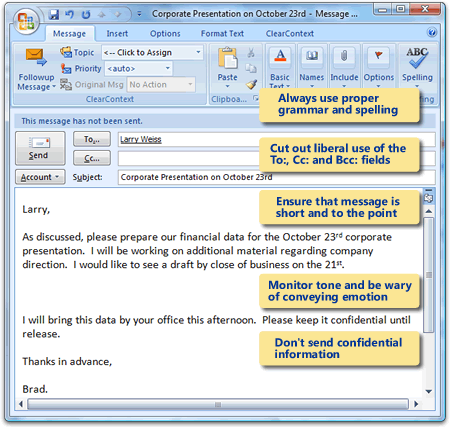As email replaces the phone as the primary method of business communication, it becomes increasingly important to craft messages that accurately communicate the idea while promoting a professional image. Below are some basic email etiquette rules that will make messages more effective.

1. Ensure that the message is well thought out, short, and to the point.
Business email should address a single issue and get directly to the subject. Don’t waste time with flowery words and long stories unless crucial to the message. Answer the sender’s issues at the top of the note and provide supporting documentation (including the original letter) at the end of the message. Anticipate questions that may arise and provide the answers in advance. Craft subject lines that accurately portray what the email is about.
2. Always use proper grammar and spelling.
Given today’s automated tools, there is no excuse for misspellings and bad grammar. You should re-read every message before hitting “send” and always use spell check functionality. This will help to avoid future clarifying letters.
3. Cut out liberal use of the To:, Cc:, and Bcc: fields.
Next to spam, wanton use of the address field is the biggest cause of inbox overflow. Only copy those who need to respond to or review the message. Be wary of the Bcc: field; many blind copied recipients will unknowingly hit Reply To All. Never send email to a distribution list by putting the recipients’ email addresses in the To: field; use Bcc: or mail merge instead.
4. Monitor tone and be wary of email that seems to convey emotion.
It is difficult to communicate subtle emotion in email, and it is often misinterpreted. Remove emotionally charged statements and stick to the facts. If an inflammatory email is received, take time to reflect and clarify the content with the author before responding in kind. If unsure of tone while composing an email, ask a co-worker to proofread before sending.
5. Don’t send confidential information.
It is very easy to forward email and consequently very easy to break confidentiality expectations. Don’t send anything that couldn’t be published in a newspaper or posted by the water cooler.
Additional Tips: Always state any action required of the reader as well as the date they must act by. Summarize long email at the beginning of the message. Pick a response time (say 8 hours) for email and try to stick to it. Provide context to your request where needed (i.e. "your boss thought you could help me with this question.")